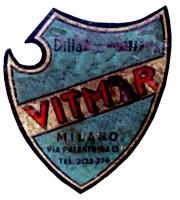From the collection of Marco Dell'Acqua, Italy.
35 Kg and 15 Kg, cast steel with makers marks.
 "Ditta ******ell**" (Ditta means "Factory")
"Ditta ******ell**" (Ditta means "Factory")
"VIT**R" (I believe that, from what can be seen of the two missing characters that the word is "VITMAR", which seems a brand name or something)
"Milano" (Milan)
"Via Palestrina 13" (factory or reseller adress)
"Tel 203-974" (telephone number)
I did a brief search for the phone number and it doesn't exist anymore.
However, in Via Palestrina 13, Milano, are currently located Officine Ansaldo (Ansaldo Ironworks) which is one of the largest, oldest italian ironworks factories. I believe that these are offices, and not any production plant, though it can have been, in the past.
Given the company name on the anvil label, which is unreadable but certainly not "Ansaldo", I don't believe the anvil was made by Ansaldo, but probably by one of the satellite workshops that often opened near such big factories. - Marco

Inspectors mark from the 35 kg GPB #6 anvil.
The interesting thing about these two anvils, one of which is definitely manufactured in Italy is that they are nearly identical in overall pattern to the
French Claudinon anvil indicating that this is a distinct pattern that manufacturers did not dare change.
 A slightly earlier but very similar anvil is shown in Diego Velazquez's "The Forge of Vulcan" 1630.
The subject being of an ancient or earlier time, the smithy used for a model was probably an old one.
This would easily place the tools in the 1500's.
A slightly earlier but very similar anvil is shown in Diego Velazquez's "The Forge of Vulcan" 1630.
The subject being of an ancient or earlier time, the smithy used for a model was probably an old one.
This would easily place the tools in the 1500's.
The difference between this and the anvils above is three hundred years of very gradual evolution.
Click image for detail.


_640.jpg)

 Return to Misc and Donated Anvils Index
Return to Misc and Donated Anvils Index Anvil Collections Gallery Index
Anvil Collections Gallery Index
35 Kg and 15 Kg, cast steel with makers marks.
"VIT**R" (I believe that, from what can be seen of the two missing characters that the word is "VITMAR", which seems a brand name or something)
"Milano" (Milan)
"Via Palestrina 13" (factory or reseller adress)
"Tel 203-974" (telephone number)
I did a brief search for the phone number and it doesn't exist anymore. However, in Via Palestrina 13, Milano, are currently located Officine Ansaldo (Ansaldo Ironworks) which is one of the largest, oldest italian ironworks factories. I believe that these are offices, and not any production plant, though it can have been, in the past. Given the company name on the anvil label, which is unreadable but certainly not "Ansaldo", I don't believe the anvil was made by Ansaldo, but probably by one of the satellite workshops that often opened near such big factories. - Marco
Inspectors mark from the 35 kg GPB #6 anvil.
The interesting thing about these two anvils, one of which is definitely manufactured in Italy is that they are nearly identical in overall pattern to the French Claudinon anvil indicating that this is a distinct pattern that manufacturers did not dare change.
The difference between this and the anvils above is three hundred years of very gradual evolution.
Click image for detail.